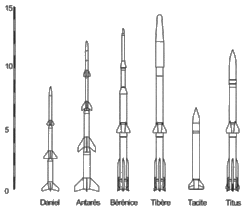Engineering:Tibère
Tibère was a French atmospheric reentry test rocket developed by O.N.E.R.A. (Office National d'Etudes et de Recherches Aérospatiales).[1][2][3] It evolved from its predecessor, Bèrènice, with development initiated in 1965 to support the ELECTRE reentry experiment program.[1][4][3] Tibère, standing at a height of 14.5 m and weighing 4.5 tons, operated as a three-stage rocket.[2]
Description
The first stage comprised a SEPR-739-2 Stromboli, that, similar to Bèrènice and Titus, was encircled by four SEPR-P167 stabilization rockets.[1][2][4][3] This was followed by another SEPR-739-2 Stromboli for the second stage, and the third stage housed a P.064 inherited from Diamant A.[1][2][4][3]
The firing of the initial two stages during ascent propelled the upper composite (3rd stage + payload) to reach an altitude of 150 km.[1] The Cassiopée attitude control system precisely oriented the composite before the P.064 motor accelerated it to high speed during descent from 130 to 60 km altitude.[1][3] The experiment itself occurred between 60 and 20 km, lasting ten seconds until the payload destruction.[1]
Launches
Despite the procurement of four Tibère units, only two flights were executed from Biscarrosse, occurring on February 23, 1971, and March 18, 1972.[1][2][3]
See also
- Bèrènice
- Antarès (OPd-56-39-22D)
- Mélanie (rocket)
- Veronique (rocket)
- French space program
References
- ↑ Jump up to: 1.0 1.1 1.2 1.3 1.4 1.5 1.6 1.7 Serra, Jean-Jacques (2013-01-15). "Fusées de l'ONERA". http://fuseurop.univ-perp.fr/onera_f.htm.
- ↑ Jump up to: 2.0 2.1 2.2 2.3 2.4 Wade, Mark (2019). "Tibere". http://www.astronautix.com/t/tibere.html.
- ↑ Jump up to: 3.0 3.1 3.2 3.3 3.4 3.5 "La fusée Tibère". 1999. http://eurospace.free.fr/tibere.html.
- ↑ Jump up to: 4.0 4.1 4.2 Krebs, Gunter D (2023). "SEPR-739 with upper stages" (in en). https://space.skyrocket.de/doc_lau/sepr739_up.htm.
 |



